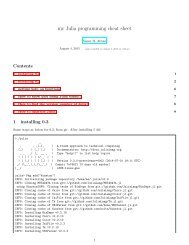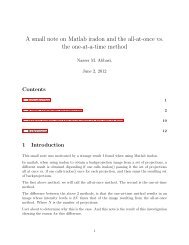You also want an ePaper? Increase the reach of your titles
YUMPU automatically turns print PDFs into web optimized ePapers that Google loves.
close all;<br />
zeta=linspace(0.1, 0.7, 10);<br />
r=linspace(0, 3, 10);<br />
D=@(r,z) (sqrt(1+(2*z*r).^2)./sqrt((1-r.^2).^2+(2*z*r).^2));<br />
figure;<br />
hold on;<br />
for i=1:length(zeta)<br />
plot(r,D(r,zeta(i)));<br />
end<br />
grid on;<br />
legend<br />
3.3 accelerometer<br />
We need transfer function between u and z a where now z a is the amplitude of the ground acceleration.<br />
This device is used to measure base acceleration by relating it linearly to relative displacement of m to base.<br />
Equation of motion. We use relative distance now.<br />
m ( u ′′ + z ′′) + cu ′ + ku = 0<br />
mu ′′ + cu ′ + ku = −mz ′′<br />
Let z ′′ = Re { Z a e iωt} . Notice we here jumped right away to the z ′′ itself and wrote it as Re { Z a e iωt} and we<br />
did not go through the steps as above starting from base motion. This is because we want the transfer function<br />
between relative motion u and acceleration of base.<br />
Now, u = Re { Ue iωt} , u ′ = Re { iωUe iωt} , u ′′ = Re { −ω 2 Ue iωt} , hence the above becomes<br />
Hence |D (r, ζ)| =<br />
m Re { −ω 2 Ue iωt} + c Re { iωUe iωt} + k Re { Ue iωt} = −m Re { Z a e iωt}<br />
−m<br />
U =<br />
−ω 2 m + iωc + k Z a<br />
−1<br />
=<br />
−ω 2 + iω2ζω n + ωn<br />
2 Z a<br />
−1<br />
=<br />
(ωn 2 − ω 2 Z a<br />
) + iω2ζω n<br />
( )<br />
−1<br />
√(ω and arg (D) = −1800 − tan −1 2ωζωn<br />
n−ω 2 2 ) 2 +(2ωζω n) 2 ωn−ω 2 2<br />
When system is very stiff, which means ω n very large compared to ω , then D (r, ζ) ≈ −1<br />
ω 2 n<br />
Z a , hence by<br />
measuring u we estimate Z a the amplitude of the ground acceleration since ω 2 n is known. For accuracy, need<br />
ω n > 5ω at least.<br />
3.4 seismometer<br />
Now we need to measure the base motion (not base acceleration like above). But we still use the relative<br />
displacement. Now the transfer function is between u and z where now z is the base motion amplitude.<br />
Equation of motion. We use relative distance now.<br />
m ( u ′′ + z ′′) + cu ′ + ku = 0<br />
mu ′′ + cu ′ + ku = −mz ′′<br />
Let z = Re { Ze iωt} , z ′ = Re { iωZe iωt} ,z ′′ = Re { −ω 2 Ze iωt} ,and let u = Re { Ue iωt} , u ′ = Re { iωUe iωt} , u ′′ =<br />
Re { −ω 2 Ue iωt} , hence the above becomes<br />
18





